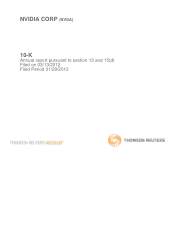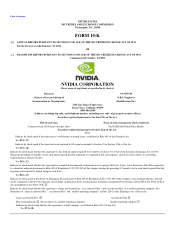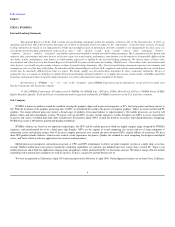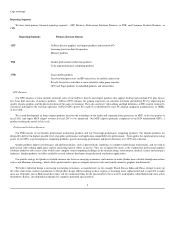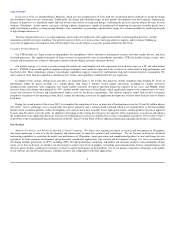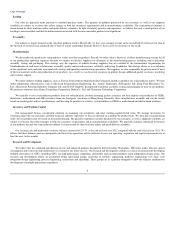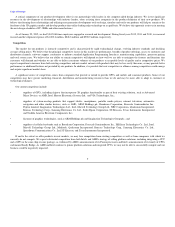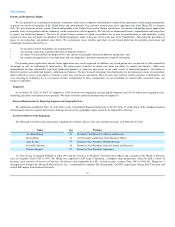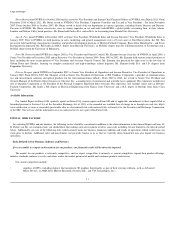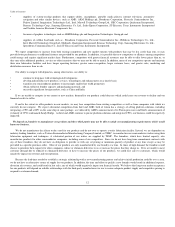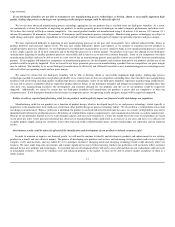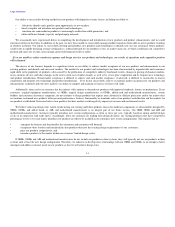NVIDIA 2012 Annual Report Download - page 5
Download and view the complete annual report
Please find page 5 of the 2012 NVIDIA annual report below. You can navigate through the pages in the report by either clicking on the pages listed below, or by using the keyword search tool below to find specific information within the annual report.
Table of Contents
PART I
ITEM 1. BUSINESS
Forward-Looking Statements
This Annual Report on Form 10-K contains forward-looking statements within the meaning of Section 27A of the Securities Act of 1933, as
amended, and Section 21E of the Securities Exchange Act of 1934, as amended, which are subject to the “safe harbor” created by those sections. Forward-
looking statements are based on our management's beliefs and assumptions and on information currently available to our management. In some cases, you
can identify forward-looking statements by terms such as “may,” “will,” “should,” “could,” “goal,” “would,” “expect,” “plan,” “anticipate,” “believe,”
“estimate,” “project,” “predict,” “potential” and similar expressions intended to identify forward-looking statements. These statements involve known and
unknown risks, uncertainties and other factors, which may cause our actual results, performance, time frames or achievements to be materially different from
any future results, performance, time frames or achievements expressed or implied by the forward-looking statements. We discuss many of these risks,
uncertainties and other factors in this Annual Report on Form 10-K in greater detail under the heading “Risk Factors.” Given these risks, uncertainties and
other factors, you should not place undue reliance on these forward-looking statements. Also, these forward-looking statements represent our estimates and
assumptions only as of the date of this filing. You should read this Annual Report on Form 10-K completely and with the understanding that our actual future
results may be materially different from what we expect. We hereby qualify our forward-looking statements by these cautionary statements. Except as
required by law, we assume no obligation to update these forward-looking statements publicly, or to update the reasons actual results could differ materially
from those anticipated in these forward-looking statements, even if new information becomes available in the future.
All references to “NVIDIA,” “we,” “us,” “our” or the “Company” mean NVIDIA Corporation and its subsidiaries, except where it is made clear
that the term means only the parent company.
© 2012 NVIDIA Corporation. All rights reserved. NVIDIA, the NVIDIA logo, 3D Vision, CUDA, DirectTouch, GeForce, NVIDIA Fermi, ICERA,
Kepler, Maximus, Quadro, Tesla and Tegra are trademarks and/or registered trademarks of NVIDIA Corporation in the U.S. and other countries.
Our Company
NVIDIA is known to millions around the world for creating the graphics chips used in personal computers, or PCs, that bring games and home movies to
life. With the invention of the graphics processing unit, or GPU, we introduced the world to the power of computer graphics. Today, we reach well beyond PC
graphics. Our energy-efficient processors power a broad range of products, from smart phones to supercomputers. Our mobile processors are used in cell
phones, tablets and auto infotainment systems. PC gamers rely on our GPUs to enjoy visually immersive worlds. Designers use GPUs to create visual effects
in movies and create everything from golf clubs to jumbo jets. Researchers utilize GPUs to push the frontiers of science with high-performance computing.
NVIDIA has nearly 5,000 patents granted and pending worldwide.
NVIDIA solutions are based on two important technologies: the GPU and the mobile processor. Both are highly complex chips, designed by NVIDIA
engineers, and manufactured for us by a third party chip foundry. GPUs are the engines of visual computing, the science and art of using computers to
understand, create and enhance images. One of the most complex processors ever created, the most advanced GPUs contain billions of transistors. We have
three GPU product brands: GeForce, which creates realistic visual experiences for gamers; Quadro, the standard in visual computing for designers and digital
artists; and Tesla, which accelerates applications for scientists and researchers.
Mobile processors incorporate central processing unit, or CPU, and GPU technologies to deliver an entire computer system on a single chip, or system-
on-chip. Modern mobile processors possess significant computing capabilities yet consume one hundred times less energy than a typical PC. Tegra is our
mobile processor and is built for applications ranging from smartphones, tablets and notebook PCs to televisions and cars. We believe energy-efficient mobile
computing will transform how computers are used in our lives. Tegra is a major new growth business for us.
We were incorporated in California in April 1993 and reincorporated in Delaware in April 1998. Our headquarter facilities are in Santa Clara, California.
4

